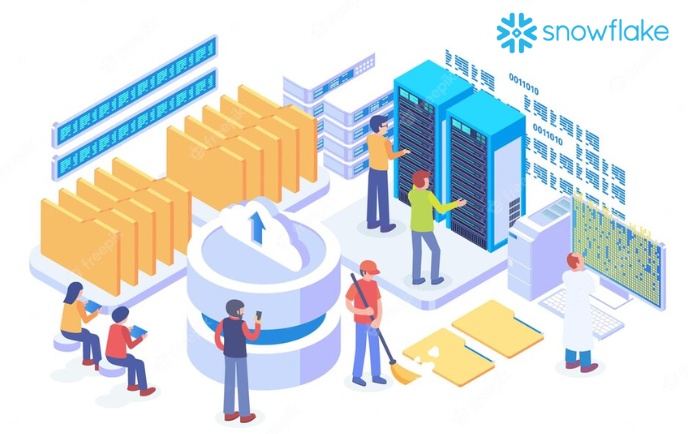As per market information, projects that the volume of data generated each year will reach 160 ZB by 2025, which is a tenfold growth over the amount of data created in 2017, and there are no indicators that this trend will slow down in the foreseeable future. In this article, we’ll explore some common problems with cloud-based data warehouses and how Snowflake can help address these issues.
The fact that this data is dispersed throughout many cloud storage locations, as well as on-premise storage, is a substantial obstacle, despite the growing popularity of using multiple cloud storage locations. The management of a hybrid mix of on-premise and cloud data warehousing technologies is a challenge that many companies are currently facing.
Another problem is the lack of integration with other tools and systems. Many cloud-based data warehouses do not offer seamless integration with other business systems and applications, making it difficult to extract insights and make data-driven decisions.
Also Read: What is the future of cloud computing, AWS or Microsoft Azure?
The Increasing Popularity of Data Warehouses
Small and large businesses alike relied on data warehouses to fulfill their requirements for data analysis and reporting prior to the development of data lakes.
One of the main challenges with cloud-based data warehouses is managing the increasing volume, variety, and velocity of data. As businesses collect more data from various sources, the complexity of managing this data grows exponentially. This can result in slow query performance and increased downtime, which can negatively impact business operations.
Snowflake data warehousing services is a trustworthy choice for your data services. With its advanced security features, full management, scalability, and excellent customer support, Snowflake is the ideal platform for storing and managing your sensitive data.
What exactly is a “Data Warehouse” you ask?
- The data warehouse, also known as the enterprise data warehouse (EDW), is the core analytics system of an organization. It combines data from various sources into a solitary, concentrated, and predictable information store to work with data investigation, data mining, AI, and machine learning.
- It gives businesses the ability to do sophisticated analyses on massive amounts of historical data, which helps them to make more educated business choices.
- An information data warehouse is quite often housed in the organization’s own facilities. Its functionality centers on retrieving data from outside sources, cleaning and preparing that data, and then putting it into a relational database and preserving it there.
- You have the option of hosting it on a dedicated application or in the cloud. A dedicated application is a mix of hardware and software components that is intended specifically for analytical processing. The vast majority of data warehouses now include analytical capabilities, data visualization tools, and presentation software.
Why Should You Trust Snowflake Data Services with Your Data?
The Unparalleled Architecture of Snowflake Allows Businesses to Concentrate on Their Data
Snowflake is a data platform that is developed in the cloud and is based on a hybrid database architecture that includes shared disks and shared nothing. Because to its innovative layout and construction, companies may make use of a number of different opportunities, including the following:
Snowflake provides advanced security features to ensure that your data is protected. This includes multi-factor authentication, data encryption, and role-based access control. These security measures help prevent unauthorized access to your data and ensure that your data is kept confidential and secure.
Performance
Scaling in both the vertical and horizontal planes of virtual warehouses enables a greater volume of data to be loaded and retrieved in a shorter amount of time. Sometimes you need to filter out what’s not essential in the information that’s being presented to you since it might be overwhelming.
Data Sharing
Through reader accounts, which can be established straight from the user interface, allows enterprises to share their data with data consumers.
Assistance with both organized and semi-structured data: Another significant advantage of using Snowflake Data services is that it is compatible with both structured and semi-structured data. It is possible to import data directly in its raw format, without the need to go through the ETL or ELT procedure beforehand.
Concurrency
When a large number of users attempt to perform the queries all at once in typical data warehouse systems, the organization will often run into concurrency concerns. However, according to the innovative multicluster architectural method used by Snowflake, queries executed inside one virtual warehouse will never have an effect on the operation of other virtual warehouses.
Billing
The multi-cluster shared data architecture that Snowflake employs allows enterprises to pay just for the computing resource on a per-second basis. This is accomplished by separating the storage resources from the computation resources. In contrast, the cost of storage is calculated on a monthly basis based on the terabytes used. Workloads are executed in parallel without any conflict because of the one-of-a-kind architectural approach that Snowflake takes.
Bottom Line
In comparison to more conventional data warehouses, Snowflake was able to assist cut operating expenses while still maintaining performance. Utilizing Snowflake resulted in error-free and straightforward data replication across databases and tables. A Snowflake Data services platform that is both powerful and well-designed will make it possible for data engineers to concentrate on the aspects of their work at which they excel namely, the development of new user experiences and platform features that are geared toward assisting customers without having to expend a significant amount of effort on the construction and upkeep of data systems.
Frequently Asked Question’s
What are common problems with cloud-based data warehouses?
Common problems with cloud-based data warehouses include managing the increasing volume, variety, and velocity of data, lack of integration with other tools and systems, and concerns over data security.
How does Snowflake help with managing the volume and complexity of data?
Snowflake is designed to easily manage and analyze massive amounts of data from multiple sources. It provides real-time performance and seamless integration with a wide range of tools and systems, making it easier to extract insights and make data-driven decisions.
Does Snowflake provide advanced security features to protect my data?
Yes, Snowflake provides advanced security features such as multi-factor authentication, data encryption, and role-based access control to ensure that your data is secure and protected from unauthorized access.
Is Snowflake a fully managed service?
A4: Yes, Snowflake is a fully managed service, meaning that all of the underlying infrastructure and maintenance are taken care of by the Snowflake team, allowing you to focus on your core business.
Can Snowflake scale to meet my changing data needs?
A5: Yes, Snowflake provides scalability so you can easily adapt to changes in your data needs. Whether you need to store and analyze petabytes of data or just a few gigabytes, Snowflake can scale to meet your requirements.
Does Snowflake provide customer support?
A6: Yes, Snowflake provides excellent customer support and the Snowflake team is available 24/7 to help with any questions or issues.

I am Evan Gilbort work with Aegis Softwares as a software developer. I have vast experience in Snowflake development, CRM, Tableau BI Development as well as Java application development.

